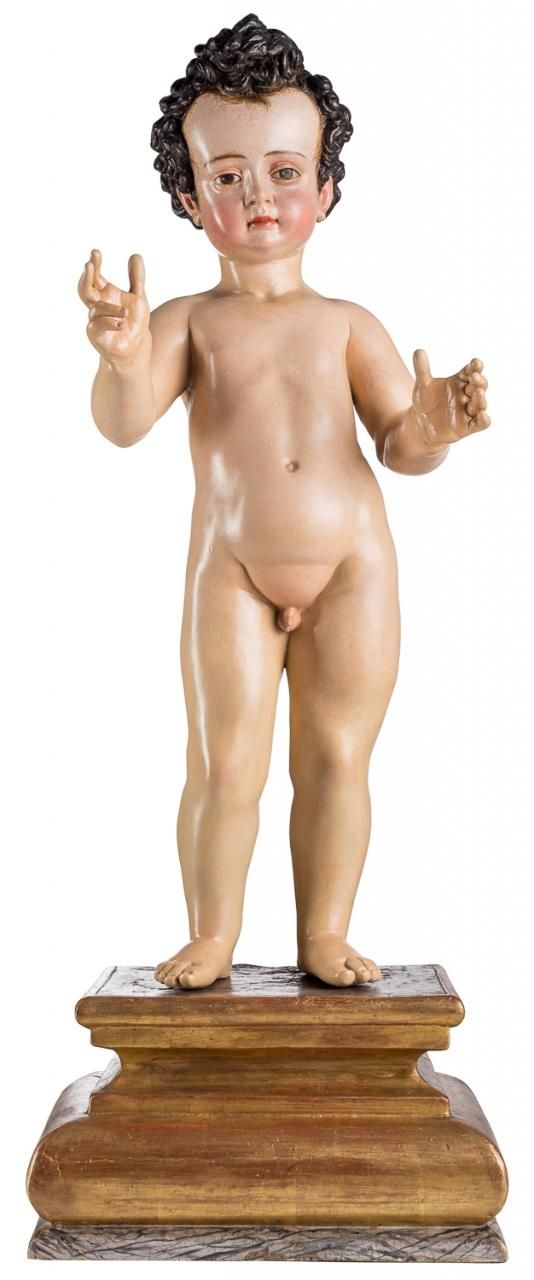Description
JUAN DE MESA Y VELASCO (matriz) / Círculo de DIEGO DE OLIVER (ejecución material)
Triumphant Infant Jesus (ca. 1620) Cast in lead with oil polychrome Without pedestal: 62 x 24 x 21 cm / With pedestal: 77 x 28 x 21 cm The piece we are studying is a round sculpture representing an Infant Jesus executed in oil polychrome lead. As usual in this type of individualized iconography of the Divine Infant, it is shown standing upright on a pedestal. Looking at his general composition, we can see a subtle counterposture. His right arm is raised and blesses in an unmistakable gesture that reveals the index and middle fingers; the left one, on the other hand, remains flexed and with the hand open, inviting us to a supposed specular embrace. _x000D_. His anatomy is that of a child's figure: a large head, narrow shoulders and torso, a bulging abdomen and short legs with round flesh. His features are: a large clear forehead, arched and raised eyebrows that frame innocent eyes, although with a deep look in front -towards the spectator-, a wide nose and a small mouth with reddish lips. The hair is dark and tangled, made up of small locks of marked volume, with a large raised tuft in the centre that gives him a singular personality. The Child stands on a simple golden base made up of a combination of concave and convex modules. _x000D_. The physiology of the piece is reminiscent of the aesthetics of the early 17th century Cordovan sculptor Juan de Mesa y Velasco, a brilliant disciple of Juan Martínez Montañés. His hand can be clearly seen in the matrix of the casting, the material execution of which we place in the circle of the Flemish artist - self-styled "master caster" - Diego de Oliver. _x000D_ _x000D_ _x000D_ _x000D_ _x000D_ _x000D_ _x000D_ This artist, of Flemish origin but based in Seville since the beginning of the 17th century, declared himself, in 1619, to be a "master caster of relief figures" and ten years later, specifically of "lead and tin children". We know that he obtained the aforementioned model of the Child of the Sacramental del Sagrario in Seville, the work of Juan Martínez Montañés, for his reproductions, at the same time as he made the lead cast of the Child in clay that the master Francisco López commissioned from Juan de Mesa on July 14, 1618. _x000D_. _x000D_. It is symptomatic to say the least that, being Juan de Mesa the creator of one of the most widespread models of the Infant Jesus, there is no documented exempt representation by his hand. However, this lack is compensated by those Infant Jesuses that form part of sculptural groups. It is true that we still have some works that we can consider safe from the sculptor and comparable to the child that concerns us, such as the example of the Faculty of Fine Arts in Seville, the one in the Museum of Fine Arts in Cordoba, as well as other representations with different critical acceptance. different critical acclaim. _x000D_. _x000D_. Among the works cast on the basis of a mould by Juan de Mesa, as we propose for our piece, the Infant Jesus of the Augustinian convent of Corpus Christi in Granada or the one in the parish of the Assumption in Osuna (Seville) stand out. _x000D_.
839
JUAN DE MESA Y VELASCO (matriz) / Círculo de DIEGO DE OLIVER (ejecución material)
